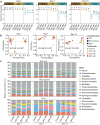Purines enrich root-associated Pseudomonas and improve wild soybean growth under salt stress
- PMID: 38664402
- PMCID: PMC11045775
- DOI: 10.1038/s41467-024-47773-9
Purines enrich root-associated Pseudomonas and improve wild soybean growth under salt stress
Abstract
The root-associated microbiota plays an important role in the response to environmental stress. However, the underlying mechanisms controlling the interaction between salt-stressed plants and microbiota are poorly understood. Here, by focusing on a salt-tolerant plant wild soybean (Glycine soja), we demonstrate that highly conserved microbes dominated by Pseudomonas are enriched in the root and rhizosphere microbiota of salt-stressed plant. Two corresponding Pseudomonas isolates are confirmed to enhance the salt tolerance of wild soybean. Shotgun metagenomic and metatranscriptomic sequencing reveal that motility-associated genes, mainly chemotaxis and flagellar assembly, are significantly enriched and expressed in salt-treated samples. We further find that roots of salt stressed plants secreted purines, especially xanthine, which induce motility of the Pseudomonas isolates. Moreover, exogenous application for xanthine to non-stressed plants results in Pseudomonas enrichment, reproducing the microbiota shift in salt-stressed root. Finally, Pseudomonas mutant analysis shows that the motility related gene cheW is required for chemotaxis toward xanthine and for enhancing plant salt tolerance. Our study proposes that wild soybean recruits beneficial Pseudomonas species by exudating key metabolites (i.e., purine) against salt stress.
© 2024. The Author(s).
Conflict of interest statement
The authors declare no competing interests.
Figures







References
-
- Zhou, H. et al. Insights into plant salt stress signaling and tolerance. J. Genet. Genomic. 10.1016/j.jgg.2023.08.007 (2023). - PubMed
Publication types
MeSH terms
Substances
Grants and funding
LinkOut - more resources
Full Text Sources

